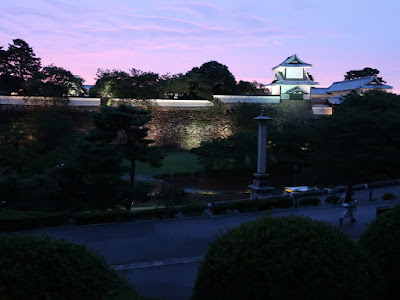American military did not bomb Kanazawa during the WWⅡ, so many old houses remain near the castle (old cit, around five kilo-meter square).
第二次世界大戦で、アメリカ軍は金沢を空襲しなかった。お城を中心に約5㎞四方に多くの古い建物が残っている。
 |
Kanazawa castle (reconstructed)
金沢、加賀百万石と言えば、やはり金沢城。
|
 |
When I visited (late August), the castle and Kenrokuen garden were lit up.
訪問した日(8月後半)は、お城も兼六園もライトアップしていて、夜も、もちろん美しい。
|
 |
Kenrokuen, which was a daimyo
garden next to the castle, was also lit up. Most Japanese know the stone
lantern on the right which is called “Kotoji-lantern”. It was a beautiful
sight, plus it was calm.
兼六園の有名な徽軫灯籠(ことじとうろう)。水面に映る庭園が美しい。私が訪れた時のライトアップは入園無料、しかも、人が少ない。
|
Ishikawa Prefectural Museum of History was a former arsenal. We can take photo but we cannot upload them on the website or printings, so photos without sources are from website of this museum.
石川県立歴史博物館は、旧陸軍の兵器庫。写真撮影は出来るが、Webにはアップロードできない。楽しい展示が沢山あるのに残念。
Daimyo (Maeda clan) and Kaga-han、前田家と加賀藩
Most attractive exhibit for me was a procession of the daimyo of Kaga-han, which based at Kanazawa . The daimyo was the most powerful daimyo at that time (Edo period). 1 million koku (150,000 tons) of rice were cropped in his territory. He went to Edo every two years, which was called “Sankin-koutai”. 2000 to 4000 of samurais and servants followed him. The model of the 2000 people procession, which was held in 1818, is exhibited on three shelves of 6 meter-width. They walked from Kanazawa to Edo; it is 480km and it took only 13 days, they walked 36 km a day on average. They walked 50 km a day for a maximum, so they needed to walk more than eight hours given they could walk 6km per hour constantly. The trip costed around 1.4 million US$, therefore they were forced to shorten trip term.
 |
Reference: The model of daimyo procession
of Kishu-han; One thousand five hundred samurais followed. 枚方宿を通過する紀州藩の大名行列、1500人規模
|
前田家の大名行列の模型が目を惹く。2,000人の行列を一人一人模型にして、約6m×3段で展示している。480kmを13日間で歩いた。平均36km、50kmを歩く日もある。早足の6km/h出歩いても8時間以上。大変なことだ。2000~4000人の行列であった。1818年は、2000人の行列で1.5億円相当の費用を要したという。
Fun of the ordinary people
人びとの楽しみ
In the ancient (Jyoumon era)、縄文時代
Dogs have lived with people from this time. They were small compared to the ones we have today. People built the water source in the forest, and wives chatted and did housework. It is the same scene as today. By the way, lacquer ware, which are specialty of Kanazawa, inaugurated around seven thousand years ago. |
Kanazawa lacquer ware、金沢漆器 @ Ishikawa Prefectural Museum of Traditional Arts and
Crafts 石川県伝統産業工芸館
|
縄文犬は豆柴みたいで小さい。犬は、古代から人と共生していたという。森の中には水場を作り、奥様方がおしゃべりしながら洗濯などの家事をしていたようだ。ところで、金沢の名産になっている漆工芸は7000年前から始まった。
Heian period (794-1185)、平安時代
A bulletin board in 849 was discovered. The order for farmers were written on it. For example,1. Farmers have to go to field at 4 am, work until 8 pm.
2. Farmers never eat fish and drink sake freely.
3. Farmers have to finish rice planting until the end of May and reported.
4. Farmers never get totally drunk and never disturb order in the village.
This means some farmers enjoyed drinking a lot.
849年の榜示札(立て札)が、北陸道の能登への追分・深見村から発掘された。
農民への命令8箇条が書かれている。①農民は、朝は寅の時(午前三時~五時)に田圃に行き、戌の時に家に帰れ。
②農民が好き勝手に魚や酒を口にすることを禁じる。
③5月30日までに田植えが終わったことを報告せよ。
④村の中で酒に酔い、秩序を乱すことを禁じる。
など。耕作をきちんとしない者、酒で大騒ぎして生活を楽しむ者が居たのだろう。
Kamakura period (1185-1333)、鎌倉時代
当地の武士の堅田(かただ)館の模型。館の外では羽根つき、独楽回しをして遊ぶ子ども、門には安穏を祈った巻数板(かんじょういた、般若心経を書写した板)が吊るされている。戦いの中でも、平和を願っている。
Internal war and the Edo period (around 1450-1867)
一向一揆の時代から江戸時代へ
Jyoudo-shin-shuu (Buddhist sect) was very powerful in this area. Ren-nyo who was a leader of this sect organized kou groups, rebelled and ruled this area around one hundred years. In the Edo period (after 1603), Maeda clan ruled this area as a daimyo of Kaga-han. Citizens’ culture flourished and many art crafts were made. |
| Model of Kanazawa castle city |
加賀では浄土真宗が力を持ち、蓮如が現れてからは、講ができて組織化し、一揆に発展した。一揆は元々は心を一つにするという意味合い。門徒の国は、信長に潰されるまで100年続いた。江戸時代に入ると加賀藩・前田家の時代へ。町人文化が花開き、工芸品が沢山作られる。
Local festivals、加賀・能登の祭り
This exhibition zone captivated me. Various local festivals are shown by models of offerings and ornaments, pictures and videos. There is also a theater in which we can see a powerful movie; it touched me a lot. For example, in “Mossou” festival, people offer huge amount of rice in a bowl. In “Saba(chub mackerel) dance ritual”, the priest dances, cuts saba fish and serves them to the participants. The energy of the ordinary people moved me. We can also see abundant smiles.People must be motivated to perform these vigorous festivals. I’m afraid it’s getting difficult to gather energetic people to execute festivals, because many people are into video games not actual events nowadays. I am really afraid that the festival culture is going to decline in Japan.
 |
| Festival theater |
私が惹かれたのは「加賀・能登の祭り」のコーナー。様々な祭りが、お供え物の模型と写真、映像で示されている。大型映像室もあり、伝わってくる。20cmばかり飯を盛る「もっそう祭り(久手川町)」、お供えのしめ鯖を持って神官がおどけ、最後にさばいて参列者に分ける「鯖踊り神事(穴水町)」。庶民のエネルギーが伝わってくる。
これだけの行事をするとなると大変なエネルギーが要る。ゲームで楽しんでいる今の時代では、祭事を行う人を集めるのは大変だ。祭の踊りや演奏などを授業に取り込む、思い切ってアニメキャラクターを作るなど工夫が必要だ。いずれにせよ、担い手がなくなるので,祭りの文化は下火にはならざるを得ないだろうか。
 |
Wooden wall which was the house of Okumura
who were one of the eight powerful samurai family in Kaga-han、加賀八家である奥村家のものだったという美しい板塀
|
 |
Dinner at Ohmichou wet market. It cost around
$22, good!
Kofuku: https://www.koufuku-kanazawa.com/en/
夕食は、近江町の口福さんでお寿司のセット(2400¥ぐらい)。美味しい。
口福:https://www.koufuku-kanazawa.com/
|
Visited in August, 2019
Official website:
http://ishikawa-rekihaku.jp/en/ (in English)
http://ishikawa-rekihaku.jp/ (in Japanese), accessed in December, 2019
Previous post (Farmer’s daily life from his diary、農家・吉野家の日記):
Yoshino’s daily life 25, December in 1851(嘉永4年12月)
Next post (Old restaurant in Kanazawa、金沢の茶屋):
Kaikaro teahouse 懐華楼



Comments
Post a Comment